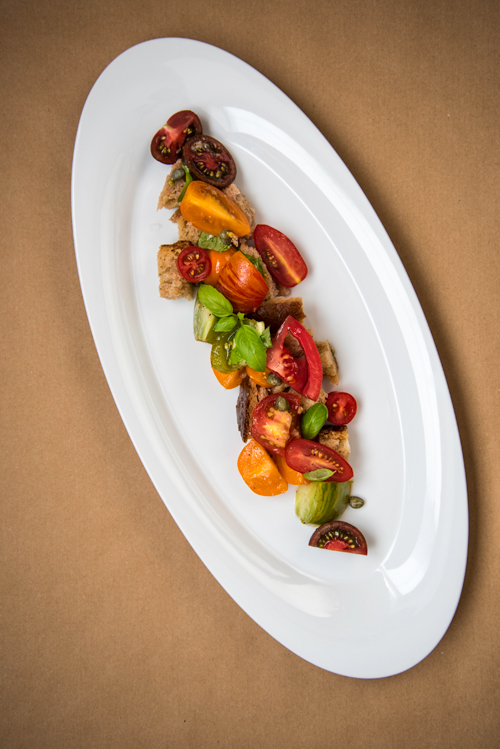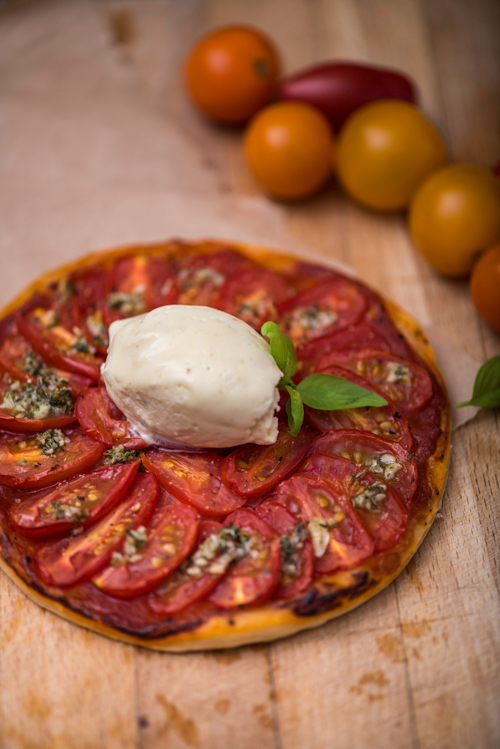Home-grown harvest: Tomatoes
Former Sienna chef-proprietor Russell Brown studies the humble tomato and shares some mouth-watering recipes
Like many ingredients, the true seasonality of an English tomato has become somewhat disguised by the use of polytunnels and heating, but September is still perhaps the height of the season and when outdoor crops can be expected.
The tomato is the berry fruit of solanum lycopersicum, a member of the nightshade family. The tomato is used extensively across the globe but originated in South America. By 500BC it was being cultivated in Southern Mexico and was first noted in England in the 1590s.
Tomatoes are widely grown in the UK but a considerable amount of the fruit is imported from Holland. Recent years have seen an increase in modern hybrids of heritage varieties being grown. This is an area that Gary Griffiths at Nutbourne Tomatoes near Pulborough in Sussex specialises in. On my visit to the nursery last month, Griffiths was growing upwards of 30 different varieties of tomato, ranging from the classic vine through to Marmande, Coeur Du Boeuf, Lemon Tiger and the San Marzano.
To produce high-quality fruit requires a lot of attention to detail from growers like Griffiths. Interestingly, the yields from the heritage varieties are significantly lower than the more classic types, with tomatoes such as the classic vine producing around 60 kilos per square metre against 25 kilos for the heritage varieties.
From sorbets to sauces, the humble tomato has a vast array of culinary possibilities.
Buying and storage tips
- Store at a cool room temperature of around 12-14°C.
- A good-quality tomato should keep for at least a week in a cool place.
- Tomatoes will continue to ripen in these conditions.
- When ripe, the fruit will feel slightly soft when pressed.
- Some varieties such as San Marzano have a higher dry-matter content, making them more suitable for drying, roasting and using in tarts.
Seasonal forecast
Expect to pay around £4 per kg for really good, unusual tomato varieties. There are cheaper tomatoes out there, of course, but varieties chosen for the best possible flavour, texture and appearance will not produce the volume of those chosen just for high yield and will therefore cost more.
Charlie Hicks
Panzanella salad
Serves six
- 200g vine cherry tomatoes
- 6tbs extra virgin olive oil
- 3tbs red wine vinegar
- 6tbs fresh tomato juice
- 6 slices of stale, rustic bread
- 2tbs capers
- 900g ripe mixed tomatoes
- 12 basil leaves
- Maldon sea salt
- Fresh black pepper
Roughly chop the cherry tomatoes (including the vine) and season with Maldon salt. Leave to macerate for at least an hour in a warm place. Strain off the juice and reserve the pulp for use elsewhere.
Make a simple dressing with the oil, vinegar and tomato juice. Season to taste. Roughly tear the bread into bite-sized pieces and toss with the dressing and capers. Cut the mixed tomatoes into pieces according to size. Add the tomatoes to the bread, season with black pepper and toss together well.
Leave to sit for 10 minutes, adjust the seasoning and finish with the torn basil.
Warm tomato tart with Parmesan mousse
Serves six
For the sauce (makes around 20 portions)
- 1 garlic clove, minced
- 2tbs extra virgin olive oil
- 200ml tomato passata
- 100ml vegetable stock
Sweat the garlic in the olive oil for a couple of minutes and then add the passata and stock. Reduce until thick and spreadable.
For the mousse
- 200g water
- 100g Parmesan, coarsely grated
- 40g egg yolk
- ½ tsp Dijon mustard
- ¾ leaf of gelatine, soaked in cold water
- Maldon sea salt
- Freshly ground black pepper
- Lemon juice
- 110g whipping cream
Combine the water and Parmesan in a heavy based saucepan. Bring to the boil, stirring occasionally, and then simmer for five minutes. Remove from the heat and allow to sit until the solids are settled. Strain off the liquid into a clean pan, pushing down well on the solids. Measure the liquid and reduce if necessary to give 150g.
Whisk together the egg yolk and mustard, whisk in the hot Parmesan liquid and return to the pan. Cook out as a custard. Add the soaked gelatine and pass through a fine chinois into a clean bowl. Allow to cool and then season to taste with salt, pepper and lemon juice. At this stage you'll want it to taste a little strong, as the whipped cream will reduce the intensity. Whip the cream to soft peaks and fold into the mousse base. Refrigerate to set.
For the tart
- 6 15cm x 4mm puff pastry discs, docked and frozen
- 6 large, ripe San Marzano tomatoes
- 1 small garlic clove, minced
- ½ tsp chopped thyme
- Extra virgin olive oil
- Maldon salt
- Freshly ground pepper
Slice the tomatoes into even slices around 5mm thick. Mix the garlic and thyme with 2tbs olive oil. Spread the puff pastry discs with the tomato sauce and then arrange tomato slices over the top, overlapping each slice slightly. Drizzle with the garlic/thyme oil and season well. Bake in a preheated oven on a heavy baking sheet at 180°C for 15-18 minutes until the pastry is golden and crisp.
To serve
- 6 raw tomato slices
- Extra virgin olive oil
Place a raw tomato slice in the centre of each tart and add a quenelle of mousse. Drizzle with olive oil and serve immediately.













